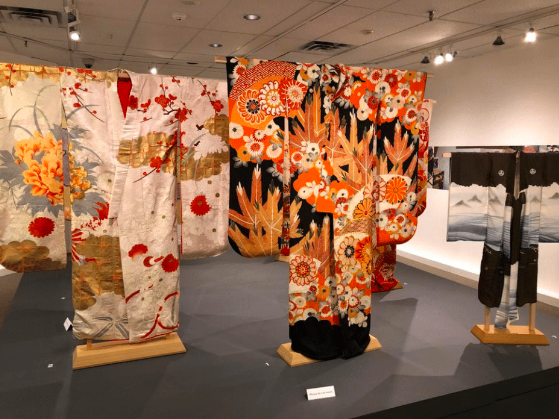Artistry in silk: The kimono of Itchiku Kubota at the Textile Museum of Canada
Hiromitsu Higashi CONTRIBUTOR
Photo: Hiromitsu Higashi / THE MIKE.
For many people, it is natural to consider merchandise branded with “Made in Japan” as a product of great design and outstanding quality. This phenomenon, sometimes deemed by scholars as a form of cognitive bias, appears to be explicable as we trace back the thousand-year history of Japanese textiles. These textiles are one of the most essential products crafted by Japanese artisans with methods developed by the efforts and experimentations of many generations. The scrupulous work of the craftspeople is presented at a seasonal exhibition of the Textile Museum of Canada (TMC): Diligence and Elegance.
For those who are interested in exploring the mysterious world of Japanese textile, the kimono is most likely what initially inspires them to do so. During the Edo period (1603–1868), the kimono evolved from relatively simple clothing to an exquisite garment decorated with a variety of techniques, including sophisticated weaving, painting, dyeing, embroidery, and application of gold and silver leaf. Variations of the kimono also have different names depending on the subtle differences in construction. They are worn according to the occasion, wearer’s age, social position, and marital status — bright colors and rich patterning are suitable for young unmarried girls, while luxurious and expensively patterned fabrics are reserved for the wealthy and upper classes.
The audiences may have already found themselves overwhelmed because while they face the blast unleashed by such a cluster of colourful, brilliant garments, there is an entirely different world to be explored when inspecting each piece of textile closely and separately. On an uchikake, an outer robe worn over another kimono, metal threads are used to depict images of waves and mountains as well as tortoise and crane figures on an extremely delicate white silk damask background already patterned with shades of pine, bamboo, plum blossoms, and citrus flowers. Additionally, even the density of foil wrapping varies on the metal threads to show the difference in brightness, alongside bamboo stalks and leaves meticulously painted to imitate shibori resist-dyeing, a task that requires a precise hand and a perfect eye.
Within the process of surface decoration of Japanese textiles, a variety of advanced techniques spirals up from the basic concept of cloth dyeing, spanning from yuzen-zome (hand-application of dye), chusen (pour-dyeing), shibori (resist-dyeing), tsutsugaki (freehand paste-resist dyeing), to katazome (stencil-dyeing). Notably among all, the famous idea of resist-dyeing — applying resist compound (usually made of a very sticky mixture of different seaweeds) to the fabrics to protect the patterns during background dyeing — has passed down to the present day with many modifications and improvements.
Walking through the hallway, all the textiles we see have something in common that reveals the nature of Japanese textiles: the craftsmen’s appreciation of nature as well as great affinity for the lands from which they derive resources, inspirations, and lives. While the textiles are all patterned with figures of plants, animals and landscapes, the Japanese reflect the idea of natural connectedness through the use of seaweeds as paste, mulberry tree skins as stencils, persimmon juice as tanning agent, and indigo as the most widely-used pigment. For more than 1400 years has indigo taken the central role among dyeing materials because the beautiful shades of blue are also believed to strengthen the fabric and possess the smell to repel snakes in rice fields. For these reasons, indigo blue has been associated with hard labour and granted the title “Japan Blue.”
It has been quite a journey when we arrive at the end of the exhibition. These masterpieces of creativity and artistry possess the capability to evoke a sudden joy or sadness, a burst of energy or a poetic reflection, and always a profound admiration for the craftsmen’s skills, faiths, and life-long time investment, expressed in every brush stroke and every stitch. In the very end, there remains little wonder why a Japanese girl considers receiving a kimono at the age of 20 as one of her most memorable moments in life.


